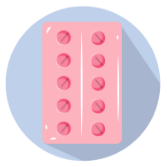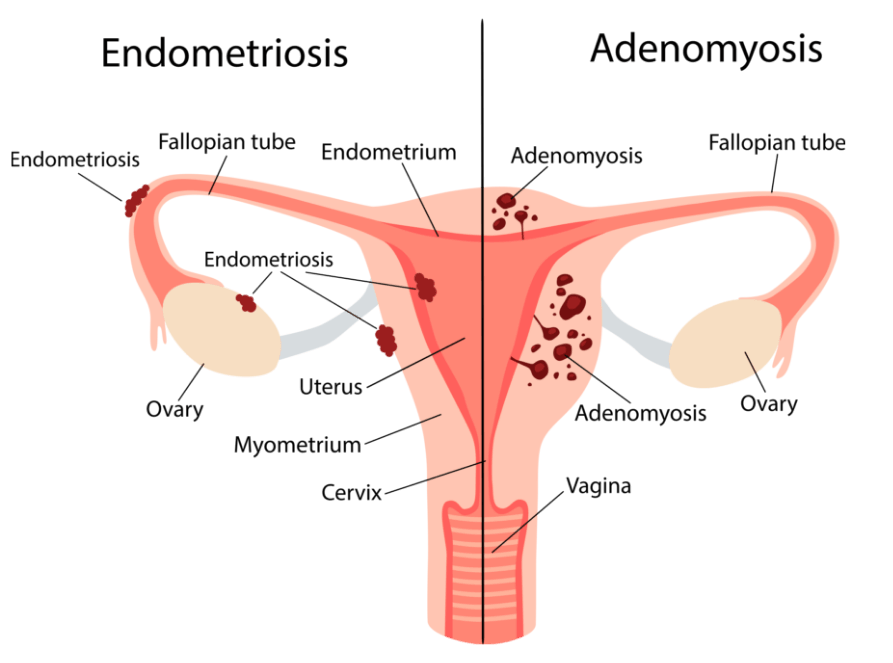With more people becoming aware of, and being diagnosed with, endometriosis, another gynaecological condition has arisen: adenomyosis.
These two conditions share similarities in not only their names, but also their symptoms, causing common misdiagnosis.
So, let’s dive in and explore the differences between:
endometriosis (end-oh-me-tree-oh-sis) and adenomyosis (add-en-oh-my-oh-sis).
Difference
The main difference between the two conditions is the location of the tissue growth.
Endometriosis is where cells that are similar to the ones lining the uterus grow outside the uterus. These cells form a tissue called endometrium, which is what thickens, breaks down, and bleeds during your period. However, when this tissue is outside the uterus, it can’t exit the body and instead thickens, bleeds, becomes inflamed, then heals, causing severe pain and creating scar tissue.
A similar cycle occurs with adenomyosis, except the difference is that those same cells grow inside the muscle wall of the uterus. When the cells bleed, they create pockets of blood in the muscle wall, causing the uterus to become enlarged.
Symptoms
The most common symptom between both conditions is period pain, but because most women are made to believe this is normal, the conditions can be extremely difficult to diagnose.
Symptoms of adenomyosis and endometriosis can also be signs of other gynaecological conditions, such as ovarian cysts or uterine fibroids. Some women may not even display symptoms, or their symptoms are so mild they don’t feel the need to see a specialist.
Both conditions can cause period pain, heavy menstrual bleeding, pelvic pain, painful intercourse, fatigue, and infertility. Adenomyosis also causes an enlarged uterus, however, this is not a symptom you can detect on your own.
Other endometriosis symptoms include: painful urination, pelvic pain at any time of the month, pain during ovulation, pain in your lower back and legs, changes in bowel habits, irregular menstrual bleeding, increased abdominal bloating, and pelvic floor muscle spasms.



Treatment
Treatment options will depend on which symptoms are present and more severe, but the most common is hormonal treatments, such as the combined oral contraceptive pill or an IUD to reduce pain and potentially slow the progression of the cell growth. These can be stopped if you are considering pregnancy.
Surgical intervention is also a recommended treatment option for both conditions. A laparoscopy is ideal for removing the cell growth for either endometriosis or adenomyosis; a hysterectomy is another option but is only recommended if the condition is severely impacting one’s quality of life.
Hysterectomies can cure adenomyosis, however there is sadly no cure for endometriosis.
Causes
The causes for adenomyosis and endometriosis are unknown, but researchers speculate a few factors could be related to the conditions.
Adenomyosis
- Having had multiple pregnancies
- Family history
- Uterine surgery from c-sections or similar procedures
- Inflammation of the uterine lining after childbirth may lead to the passage of cells into the weakened muscle layer
- Presence of cells in the uterine muscle wall before birth
- Being aged 30-50
- Prior ectopic pregnancy
Endometriosis
- Family history
- Retrograde menstruation
- Periods lasting longer than 5 days
- Short menstrual cycle (less than 27 days)
- Getting your period before you turned 12 years old
- Heavy bleeding during your periods
- Having your first pregnancy at an older age
- Changes in your immune system
If you’re concerned about potentially having either endometriosis or adenomyosis, contact the compassionate team at Northside Gynaecology and schedule a free nurse chat with one of our specialist nurses.


